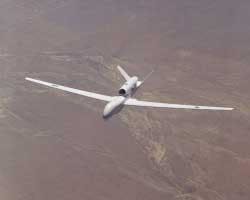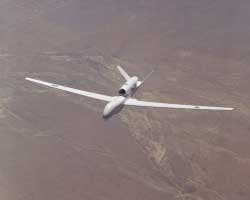Mercury multicomputer systems used for Air Force radar program
By John McHale
HANSCOM AFB, Mass. — Northrop Grumman Corp. in Baltimore has selected real-time PowerStream multicomputers from Mercury Computer Systems of Chelmsford, Mass., for use in Phase 1 of the U.S. Air Force Multi-Platform Radar Technology Insertion program (MP-RTIP).
The MP-RTIP team at the Air Force's Electronic Systems Center at Hanscom Air Force Base, Mass., works with prime contractor Northrop Grumman and teammate Raytheon in Lexington, Mass., to design a common, modular, scaleable Active Electrically Scanned Array or AESA radar.
The AESA radar is for future integration on Global Hawk unmanned aerial reconnaissance system, the Multi-sensor Command and Control Aircraft (MC2A), and a sensor for the NATO Alliance Ground Surveillance System. The entire program will cost $2 billion and will develop the three radars and retrofit five Joint STARS aircraft with the new radar capability, Hanscom officials say.
"MP-RTIP is one of the U.S. military's most strategic radar programs," says Vince Mancuso, vice president and general manager of Mercury's Defense Electronics Group. "We believe that our systems will play an integral part in developing a solution that will integrate easily into a variety of platforms."
The PowerStream MP-510 system, designed as the second generation of multiported RACE systems, combines intra-system communication bandwidth with high computational density in one deployable, embedded multicomputer system, Mercury officials say. The high-speed interprocessor communications capability is the key to obtaining maximum performance for applications such as high-end radar and signals intelligence, company officials say.
Moving data to the processors in multiprocessor systems becomes the primary barrier to increased system performance with the continuing advances in processor speeds, Mercury officials say. The PowerStream system solves this problem by providing eight RACE++ ports for each of the 10 9U VME boards and boosting bisection bandwidth to faster than eight gigabytes per second — quadruple the performance of standard RACE++ VME systems and of Mercury's RACE Series Multiport 410, Mancuso says. The MP-410 has 120 billion floating-point operations per second (GFLOPS) of processing power while the PowerStream 510 systems have more than 500 GFLOPS — 16 times the density of the MP-410, he adds.
"Doubling the number of RACE ++ ports from four to eight on the board has created a huge amount of bandwidth," Mancuso says.
The MP-RTIP improves radar to enable fighting forces to locate, track, assess, and attack enemy targets within minutes for manned and unmanned aircraft. The MP-RTIP became an independent program office last year after the secretary of the Air Force approved the restructuring of the existing RTIP that was part of the Joint Surveillance Target Attack Radar System (Joint STARS) program office, Hanscom officials say.
"Our goal is to field a family of modular, scalable radars for Global Hawk, the NATO Transatlantic Advanced Radar Program and the next generation Wide Area Surveillance platform," says Lt. Col. Joseph Smyth, MP-RTIP program director. "The MP-RTIP is a key step in achieving General Jumper's vision of a Global Strike Task Force by fielding a family of sensors for the Multi-Sensor Command and Control Constellation. MP-RTIP leverages off the considerable investment the DOD has made in Advanced Electronically Scanned Array radars, particularly the F-22 and Joint Strike Fighter."
"The program office has made great strides in restructuring the program this past year from a Joint STARS radar upgrade into a true multi-platform program that can meet the needs of our war-fighters for battlefield surveillance," Smyth says. "My priorities for the coming year are to execute the Interim Design Review, support the war-fighter as he decides which platform the Wide Area Surveillance radar will go on, and help to achieve a consensus as to the makeup of a NATO owned and operated battlefield surveillance capability."
Technology refresh is important on the board and component level as well, Mancuso says. The key is to make the software independent of the hardware, he explains. The majority of refresh costs will be in software — writing code that will work with old and new hardware, Mancuso continues. At Mercury 70 percent of the employees were hardware engineers 10 years ago, now 70 percent are software engineers, Mancuso says.
null

